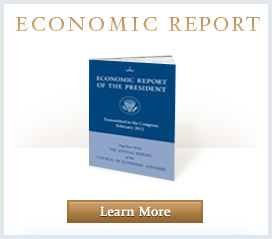Strengthening the Rural Economy - Improving America's Support of Agriculture
V. IMPROVING AMERICA’S SUPPORT OF AGRICULTURE
Agriculture remains central to the lives and livelihoods of rural Americans, and the U.S. agricultural sector is one of the most productive in the world. The Administration’s policies for the rural economy seek to support American agriculture, further enhance its productivity, and continue to protect farmers from large fluctuations in yields and prices. This section discusses three types of policies the President has proposed to strengthen American agriculture: expanding overseas market access, better targeting of farm support programs, and promoting local and regional food systems.
A. Opening Markets to U.S. Agricultural Exports
As part of the Administration’s National Export Initiative, the President has called for further measures to open foreign markets to American products. A key beneficiary of such expanded opportunities will be American agriculture, which is extremely competitive in international markets.
The President recently called for concluding the Doha round of trade negotiations, a large component of which is related to opening up agricultural markets around the world. This would require countries to reduce protective tariffs and distortive subsidies in their agricultural sectors. More open trade allows the highly productive U.S. agricultural sector to export its products more easily. Further, the United States tends to have lower barriers to trade than many other countries. As discussed previously, the change in access that has resulted from previous free trade agreements has often been bigger for U.S. exporters than importers into the United States. An agreement such as this would allow the United States to reform policies that have been in some cases ruled noncompliant with the World Trade Organization (such as the subsidies for cotton). Having subsidies that are ruled illegal can cause damage to the industry and other sectors as other countries are allowed to impose retaliatory tariffs on U.S. goods.
Finally, as discussed in Box 4, the Administration is working to promote fair competition in agriculture not only internationally, but also at home.
The Administration is committed to protecting fair and open competition and enforcing antitrust laws in the agricultural sector. The Department of Justice and the Department of Agriculture are holding five public outreach workshops in 2010 to solicit public input on the state of competition, regulation, and consolidation in the agricultural industry. One aim of these workshops is to foster dialogue and ensure that a wide variety of viewpoints are heard on issues such as the impact of agriculture concentration on food costs, how patents and intellectual property affect agricultural marketing and production, and increasing retailer concentration. The first such event, held in Iowa in March, drew hundreds of farmers, ranchers, and industry leaders, who participated in a vigorous discussion about competition in markets ranging from seeds to livestock. Four more workshops have already been scheduled in 2010 to focus specifically on the poultry, livestock, and dairy markets.
B. Reforms to Existing Farm Support Programs
The Federal government initiated programs to support farm income in 1933 as part of the New Deal. This first incarnation of Federal support took the form of payments to farmers who let a portion of their fields lie fallow to reduce crop supply and raise the price of farmed goods. The initial program spawned an array of other programs specifically targeted to the agricultural sector, including commodity price supports and production controls, marketing orders to limit competition, import barriers, and crop insurance.
Since that time, Federal support for agriculture has evolved away from programs that pay farmers not to farm toward less distorting fixed direct payments based on a farm’s historic production. In addition, current Federal support includes countercyclical payments to help protect farmers against changes in current prices, programs that subsidize loans or provide the financial benefits of a loan when commodity prices are low, crop insurance at subsidized rates, and disaster- and revenue-based programs. Finally, the government provides conservation payments to farmers who set aside environmentally-sensitive land or adopt conservation practices on land that they farm. Payments to farmers of specific crops or animal products constituted about 70 percent of all direct farm support in 2008.22 Of this amount, corn producers received about 29 percent, followed by upland cotton with 25 percent, 15 percent for tobacco, 14 percent for wheat, 7 percent for soybeans, and 5 percent for rice.
Figure 10 tracks trends in total agricultural employment and farm support payments since 1948.23 The farm support series is smoothed across three years and includes both direct payments and subsidies for crop insurance. Although there has been substantial variation due to price and yield shocks, two patterns are evident: the number of people employed in the agricultural sector has consistently declined, while total farm support (in 2008 dollars) has tended to increase. That said, farm support has been generally declining since 2000: the total level of farm support has fallen from about $43 billion in 2000 to about $21 billion in 2009. This trend appears to be driven largely by high commodity prices due to high foreign demand for U.S. agricultural products and the growing biofuels market. Subsidy rates for most direct payment programs between the 2002 and 2008 Farm Bills remained largely unchanged.
The Administration’s proposed fiscal year 2011 budget includes a number of reforms to existing Federal support for the agricultural sector. First, to better target payments, it proposes more stringent income eligibility requirements to preclude the wealthiest farmers from receiving payments.24 Currently, farms with $500,000 or more in sales receive 38 percent of subsidies, although they account for only 4 percent of farms.25 In the Administration’s budget, after being phased in over three years, farmers with a farm-adjusted gross income (AGI) over $500,000 or nonfarm AGI over $250,000 would no longer be eligible for direct payments. Second, it proposes reforming the crop insurance program to reduce windfall profits enjoyed by private companies that supply reinsurance. The crop insurance program has grown dramatically since it began in 1981, from $18 million to $7 billion in 2009 (all in 2008 dollars). This change to the crop insurance program is projected to save $8 billion over 10 years. Together, these reforms ensure that the Federal government will continue to provide a safety net to farmers while freeing up resources that can then be directed toward other priorities.
C. Promoting Local and Regional Food Systems
The Administration is promoting the development of local and regional food systems that deliver fresh food to consumers who live in close proximity to farms. Local food systems promote healthful living through increased availability of fresh food to underserved areas and the provision of better information on where food was grown. Locally grown food also may have greater nutrition value, since it does not have to be picked as early or treated to maintain freshness for transport to distant places. Finally, local food systems may reduce income variability and increase the share of the final product price that goes to farmers.
Several programs support this goal. Department of Agriculture initiatives such as Know Your Farmer, Know Your Food support local food systems and help consumers make better-informed decisions about their food. This particular initiative assists schools participating in school nutrition programs to purchase more locally grown foods where possible. The First Lady has also been involved in promoting healthy food initiatives, many of which emphasize the importance of local, healthy food production. For example, a key focus of her Let’s Move! campaign is to help ensure that all families have access to healthy, affordable food in their local communities. Meanwhile, the President’s proposed fiscal year 2011 budget includes the Healthy Food Financing Initiative, a new program designed to provide grants to bring farmers’ markets and fresh foods into underserved communities. Three separate departments -- Treasury, Agriculture, and Health and Human Services -- are collaborating on this initiative, which will invest up to $400 million annually.
22 The credit provided to blenders of renewable fuels is not included in this amount.
23 Farm employment consists of self-employed and unpaid family workers, and full-time and part-time wage and salary workers. Thus, farm employment includes workers who do not statutorily receive payments (for example, wage workers), and some who receive payments are not included (for example, retired farmers who still receive direct payments).
24 As Secretary Vilsack testified, “Recognizing the need to reduce the deficit, the budget proposes to better target direct payments to those who need and can benefit from them most as well as cap total payments paid to larger operations.” The budget also “reflects savings expected to be achieved through reforms in the Federal crop insurance program. The changes we are proposing will help protect farmers from higher costs, rein in costs for taxpayers, improve access to crop insurance and provide greater protection from crop losses” (Vilsack 2010).
25This is calculated from tabulations at www.ers.usda.gov/Briefing/FarmIncome/govtpaybyfarmtype.htm using data from the 2007 Department of Agriculture’s Agricultural Resource Management Survey.


